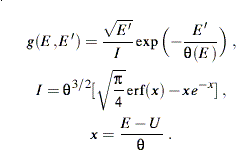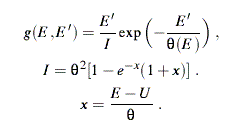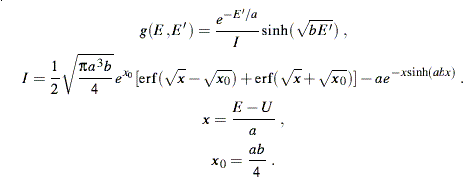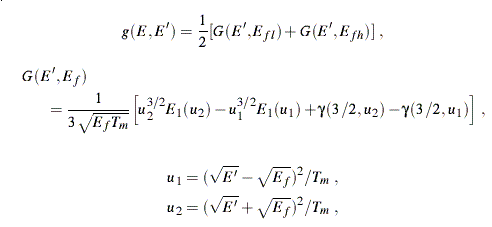Data Formats and Procedures for the
Evaluated Nuclear Data File ENDF-6.
File 5 is used to describe the energy distribution of a secondary particle expressed as normalized probability distributions. File 5 is used for incident neutron reactions and spontaneous fission only; reactions induced by charged particles will be represented in File 6. Energy distributions for two-body reactions, such as elastic scattering (MT=2), discrete inelastic levels (MT=51-90), or charged-particle levels (MT=600 series) can be computed directly from the angular distributions in File 4, and those reactions will not appear in File 5. Reactions with appreciable energy-angle correlation are best represented using File 6.
The representation provided by File 5, except possibly for fission, is inadequate for modern evaluations, and it is gradually being supplanted by File 6.
The distributions given in File 5 are normalized so that

and they can be broken down into partial energy distributions of the form

where the pk are the fractional probabilities for each of the partial distributions fk at energy E. The partial distributions can be represented using one of six different distribution laws, as described below.
Secondary Energy Distribution Laws
LF=1, Arbitrary tabulation function: A set of incident energies is given, and a normalized tabulated distribution g(E,E') is given at each incident energy E.
LF=5, General evaporation spectrum: A temperature-like quantity θ is tabulated against incident energy E, and a single spectrum is tabulated as a function of E'/θ(E).
LF=7, Simple Maxwellian fission spectrum: The effective temperature θ is tabulated against the incident energy E, and the spectrum is given by

The constant U is introduced to define the range of final energies allowed (zero to E-U).
LF=9, Evaporation spectrum: The effective temperature θ is tabulated against the incident energy E, and the spectrum of emitted particles is given by

The range of final energies allowed is from zero to E-U.
LF=11, Energy-dependent Watt spectrum: Two functions a(E) and b(E) are tabulated, and the spectrum is calculated using

The range of final energies allowed is from zero to E-U.
LF=12, Madland-Nix fission spectrum: Two constants EFL and EFH, the average kinetic energies of the light and heavy fragments, respectively, and a temperature-like quantity TM(E) are tabulated, and the spectrum is computed using

where E1 and γ are the standard exponential integral and gamma functions.
Formats
Each section of File 5 contains the data for a particular reaction type (MT number), starts with a HEAD record, and ends with a SEND record. A section may be divided up into several subsections, each containing the data for one partial energy distribution. The structure of a subsection depends on the value of LF. The following quantities are defined:
- NK
- number of partial distributions.
- U
- constant that defines the upper energy limit for the secondary particle; the energy can vary from 0 to E-U.
- θ
- effective temperature used to parameterize the secondary energy distribution for LF=5, 7, or 9.
- LF
- flag specifying the distribution law for this subsection.
- pk(E)
- fraction of the distribution that can be described by the partial distribution in this subsection.
- fk(E)
- partial distribution in this subsection.
- a,b
- energy-dependent parameters used in the Watt spectrum,
- EFL,EFH
- constant parameters used in the Madland-Nix spectrum,
- TM
- energy-dependent parameter used in the Madland-Nix spectrum,
The structure of a section of File 5 has the following form: